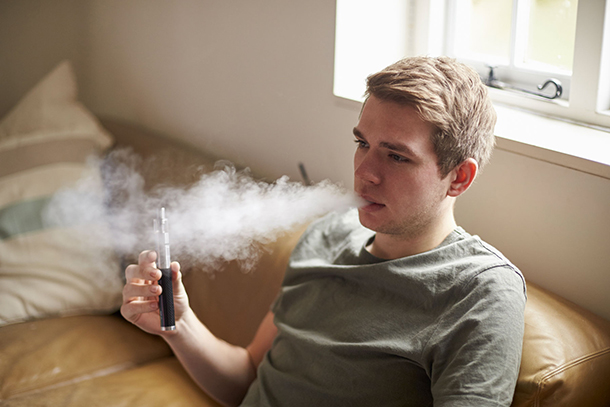A new study debunks the popular belief that electronic cigarettes are merely a substitute for cigarettes among teens, instead, suggesting that some teens who never would have smoked cigarettes are now vaping.
A Keck School of Medicine of USC study of 5,490 high school juniors and seniors shows tobacco use among teens in Southern California is on the rise. The study, published July 11 in the journal Pediatrics, followed five groups of high schoolers who graduated in 1995, 1998, 2001, 2004 and 2014. Researchers collected the history of tobacco use in an individually administered questionnaire.
E-cigarettes, which entered the U.S. market in 2007, vaporize liquids that may or may not contain nicotine. In 2011, about 1.5 percent of high schoolers had vaped in the past 30 days, according to the National Youth Tobacco Survey. Four years later, that number skyrocketed to 16 percent.
In 2014, about 14 percent of 12th-graders said they had either smoked or vaped in the previous 30 days. A decade earlier — before e-cigarettes were sold in the United States — 9 percent of surveyed teens in this age group reported that they had smoked, said Jessica Barrington-Trimis, lead author and a postdoctoral scholar research associate in the Department of Preventive Medicine at the Keck School.
“If teenagers who vape are using e-cigarettes instead of cigarettes, we would have expected to see the decline in smoking rates continue through 2014,” Barrington-Trimis said. “But what we’ve seen is a downward trend in cigarette use from 1995 to 2004 but no further decrease in cigarette smoking rates in 2014. The combined e-cigarette and cigarette use in 2014 far exceeded what we would have expected if teens were simply substituting cigarettes with e-cigarettes. The data suggest that at least some of the teens who are vaping would not have smoked cigarettes.”
Cigarette use is the largest preventable cause of death and disease in the United States. Cigarette smoking kills more than 480,000 Americans annually, according to the Centers for Disease Control.
“An important question in the rapidly evolving landscape of youth tobacco product use is whether e-cigarettes are replacing cigarettes,” said Rob McConnell, the study’s senior author and professor of preventive medicine at Keck Medicine of USC. “However, use of e-cigarettes by youth who would not otherwise have smoked results in exposure to the hazards of inhaled vaporized liquids and flavorings in e-cigarettes and may result in exposure to nicotine that can damage the adolescent brain.”
USC is one of 14 U.S. research institutions that received National Institutes of Health funding to establish the Tobacco Centers of Regulatory Science.
The National Youth Tobacco Survey has reported a long-term decline in teen smoking rates followed by a leveling off between 2014 and 2015.
The USC study found that the number of 12th-graders in Southern California who had smoked in the past 30 days dropped from 19 percent in 1995 to about 9 percent in 2004 and then leveled off, with the rate of smoking just under 8 percent in 2014.
But when cigarettes and e-cigarettes were combined, some 14 percent of high school seniors in 2014 said they had smoked or vaped in the last 30 days.
“Because e-cigarettes are perceived as less harmful and less dangerous than combustible cigarettes, another concern is that teens may be introduced to nicotine use via e-cigarettes,” Barrington-Trimis said. “In California, where smoking rates are among the lowest in the country, the increase in vaping, possibly followed by increases in smoking, could erode the progress that has been made over the last several decades in tobacco control.”
In fact, older teens who experiment with electronic cigarettes are six times more likely to try regular cigarettes within about a year when compared to those who have never vaped, reported Barrington-Trimis and her USC colleagues in a study published in June in Pediatrics.
Although some e-liquid providers say their products do not contain nicotine, this industry has not been regulated until just recently. The U.S. Food and Drug Administration announced plans to regulate all tobacco products — including e-cigarettes, cigars and hookah tobacco — in May. Last month, California became the second state, behind Hawaii, to raise the age of tobacco purchase — including e-cigarettes — from 18 to 21.
“E-cigarettes may be recruiting a new group of kids to tobacco use,” Barrington-Trimis said. “E-cigarettes may be safer than regular cigarettes for adults who are transitioning from smoking to vaping, but for youth who have never used any other tobacco products, nicotine experimentation could become nicotine addiction.”
The study was supported by the National Institutes of Health National Cancer Institute and the Food and Drug Administration Center for Tobacco Products (P50CA180905).
— Zen Vuong


